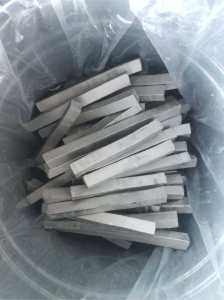The use of niobium As an additive for iron-based, nickel-based and zirconium-based superalloys, niobium can improve their strength properties. In the atomic energy industry, niobium is suitable to be used as the structural material of reactor and the cladding material of nuclear fuel, as well as the thermal protection and structural material in the aviation and aerospace industries. Niobium capacitance is similar to tantalum capacitance, but due to the small density of niobium, the capacitance per unit volume is larger. Niobium titanium, niobium zirconium alloy, niobium tin, niobium aluminum germanium and other compound superconductive materials are not only used for power transmission, power generation, manufacturing of superconducting magnets, and control of nuclear fusion, but also used for navigation devices in spacecraft, electromagnetic propulsion equipment for high-speed diving vessels, and superconducting superclass high-speed trains. The acid corrosion resistance of niobium is better than that of zirconium, but not as good as that of tantalum. It can be used as heat exchanger, condenser, filter, agitator, etc. Niobium carbide can be used alone or in combination with tungsten carbide and molybdenum carbide as hot forging dies, cutting tools, jet engine turbine blades, valves, tail skirts and rocket nozzle coatings. Niobium-containing alloy steel has high strength, good toughness and cold quenching resistance, and is widely used in oil pipelines. Lithium niobate single crystal is used in color TV sets. The nature of niobium niobium is a refractory rare metal with steel gray luster, and its melting point is 2467. C. The density is 8.6 g/cm3. Niobium has good low-temperature plasticity and can be processed into various semi-finished products by cold pressure. High temperature resistance, high strength, at 1000. C and above still have sufficient strength, plasticity and thermal conductivity. Superconductivity is best at extremely low temperatures, such as minus 260. The resistance is close to zero at about C. At 150. Below C, it is resistant to chemical corrosion and atmospheric corrosion. It is stable for many acid and salt solutions at room temperature, but soluble in hydrogen embrittlement. A stable oxide film is formed during anodization. In natural minerals, niobium. A stable oxide film is formed during anodization. In natural minerals, niobium and tantalum coexist. Minerals containing niobium and tantalum include pyrochlore, niobium-tantalite, limonite, niobium-titanium-bearing rutile, rutile and niobium-tantalate placer. Some steelmaking slag and tin smelting slag are also important resources for refining niobium. The classification of niobium ore or tantalum ore is mainly determined by the amount of niobium or tantalum in the mineral. The Nb-Tn superconducting magnetic properties have reached the international level. Baoji Research Institute of Rare Nonferrous Metal Processing has successfully trial-produced an inserted multi-core Nb-Tn superconducting magnet with an inner diameter of 23.5 mm using its own wire. Compared with conventional magnets, this kind of magnet has small volume, light weight and high magnetic field strength; After power-on and closed operation, power supply is not required for long-term operation. According to the test conducted by Chinese and French scientific and technological personnel in the high-field laboratory of the National Research Center of France, at - 286.96 ℃, the central field strength of the magnet reaches 154000 Gauss, and its performance reaches the international level.
Post time: Mar-09-2023
